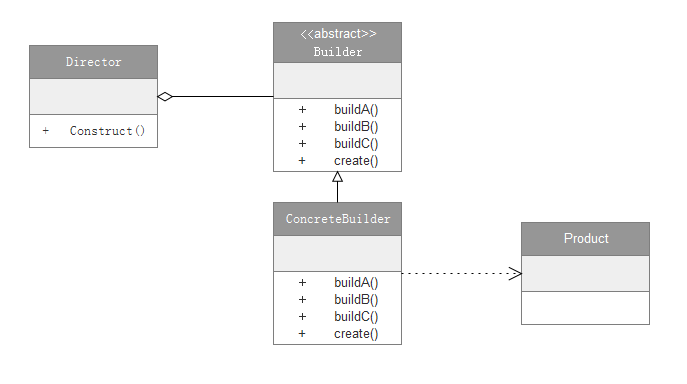Android的设计模式-建造者模式
前言
Android的设计模式系列文章介绍:欢迎关注,持续更新中:
Android的设计模式-设计模式的六大原则
创建型模式:
Android的设计模式-单例模式
Android的设计模式-建造者模式
Android的设计模式-工厂方法模式
Android的设计模式-简单工厂模式
Android的设计模式-抽象工厂模式
Android的设计模式-原型模式
行为型模式:
Android的设计模式-策略模式
Android的设计模式-状态模式
Android的设计模式-责任链模式
Android的设计模式-观察者模式
1.定义
将一个复杂对象的构建与它的表示分离,使得同样的构建过程可以创建不同的表示。
2.介绍
- 建造者模式属于创建型模式。
- 建造者模式主要用来创建复杂的对象,用户可以不用关心其建造过程和细节。
- 例如:当要组装一台电脑时,我们选择好CPU、内存、硬盘等等,然后交给装机师傅,装机师傅就把电脑给组装起来,我们不需要关心是怎么拼装起来的。
3.UML类图
角色说明:
- Product(产品类):要创建的复杂对象。在本类图中,产品类是一个具体的类,而非抽象类。实际编程中,产品类可以是由一个抽象类与它的不同实现组成,也可以是由多个抽象类与他们的实现组成。
- Builder(抽象建造者):创建产品的抽象接口,一般至少有一个创建产品的抽象方法和一个返回产品的抽象方法。引入抽象类,是为了更容易扩展。
- ConcreteBuilder(实际的建造者):继承Builder类,实现抽象类的所有抽象方法。实现具体的建造过程和细节。
- Director(指挥者类):分配不同的建造者来创建产品,统一组装流程。
4.实现
4.1 定义具体的产品类(Product):电脑
public class Computer {
private String mCPU;
private String mMemory;
private String mHD;
public void setCPU(String CPU) {
mCPU = CPU;
}
public void setMemory(String memory) {
mMemory = memory;
}
public void setHD(String HD) {
mHD = HD;
}
}
4.2 定义抽象建造者(Builder):组装电脑的过程
public abstract class Builder {
public abstract void buildCPU(String cpu);//组装CPU
public abstract void buildMemory(String memory);//组装内存
public abstract void buildHD(String hd);//组装硬盘
public abstract Computer create();//返回组装好的电脑
}
4.3 创建具体的建造者(ConcreteBuilder):装机人员
public class ConcreteBuilder extends Builder {
//创建产品实例
private Computer mComputer = new Computer();
@Override
public void buildCPU(String cpu) {//组装CPU
mComputer.setCPU(cpu);
}
@Override
public void buildMemory(String memory) {//组装内存
mComputer.setMemory(memory);
}
@Override
public void buildHD(String hd) {//组装硬盘
mComputer.setHD(hd);
}
@Override
public Computer create() {//返回组装好的电脑
return mComputer;
}
}
4.4 定义指挥者类(Director):老板委派任务给装机人员
public class Director {
private Builder mBuild = null;
public Director(Builder build) {
this.mBuild = build;
}
//指挥装机人员组装电脑
public void Construct(String cpu, String memory, String hd) {
mBuild.buildCPU(cpu);
mBuild.buildMemory(memory);
mBuild.buildHD(hd);
}
}
4.5 测试方法
public void CreatComputer() {
Builder builder = new ConcreteBuilder();//创建建造者实例,(装机人员)
Director direcror = new Director(builder);//创建指挥者实例,并分配相应的建造者,(老板分配任务)
direcror.Construct("i7-6700", "三星DDR4", "希捷1T");//组装电脑
}
5.应用场景
- 创建一些复杂的对象时,对象内部的构建过程存在复杂变化。
- 相同的构建过程,不同的执行顺序,产生不同结果时。
- 不同配置的构建对象,产生不同结果时。
6.优点
- 封装性良好,隐藏内部构建细节。
- 易于解耦,将产品本身与产品创建过程进行解耦,可以使用相同的创建过程来得到不同的产品。也就说细节依赖抽象。
- 易于扩展,具体的建造者类之间相互独立,增加新的具体建造者无需修改原有类库的代码。
- 易于精确控制对象的创建,由于具体的建造者是独立的,因此可以对建造过程逐步细化,而不对其他的模块产生任何影响。
7.缺点
- 产生多余的Build对象以及Dirextor类。
- 建造者模式所创建的产品一般具有较多的共同点,其组成部分相似;如果产品之间的差异性很大,则不适合使用建造者模式,因此其使用范围受到一定的限制。
- 如果产品的内部变化复杂,可能会导致需要定义很多具体建造者类来实现这种变化,导致系统变得很庞大。
8.Android中的源码分析
Android中的AlertDialog.Builder就是使用了Builder模式来构建AlertDialog的。
8.1 AlertDialog.Builder的简单用法
AlertDialog.Builder builder = new AlertDialog.Builder(activity);//创建一个Builder对象
builder.setIcon(R.drawable.icon);
builder.setTitle("标题");
builder.setMessage("信息");
builder.setPositiveButton("确定",
new DialogInterface.OnClickListener() {
@Override
public void onClick(DialogInterface dialog, int which) {
}
});
AlertDialog alertDialog = builder.create();//创建AlertDialog对象
alertDialog.show();//展示AlertDialog
通过Builder对象来构建Icon、Title、Message等,将AlertDialog的构建过程和细节隐藏了起来。
8.2 AlertDialog相关源码分析
//AlertDialog源码
public class AlertDialog extends Dialog implements DialogInterface {
private AlertController mAlert;//接受Builder成员变量P的参数
AlertDialog(Context context, @StyleRes int themeResId, boolean createContextThemeWrapper) {
super(context, createContextThemeWrapper ? resolveDialogTheme(context, themeResId) : 0, createContextThemeWrapper);
mWindow.alwaysReadCloseOnTouchAttr();
mAlert = AlertController.create(getContext(), this, getWindow());//创建AlertController对象
}
@Override
public void setTitle(CharSequence title) {//设置Title
super.setTitle(title);
mAlert.setTitle(title);//保存在AlertController对象中
}
public void setMessage(CharSequence message) {//设置Message
mAlert.setMessage(message);//保存在AlertController对象中
}
public void setIcon(@DrawableRes int resId) {//设置Icon
mAlert.setIcon(resId);//保存在AlertController对象中
}
@Override
protected void onCreate(Bundle savedInstanceState) {
super.onCreate(savedInstanceState);
mAlert.installContent();//安装AlertDialog的内容
}
//AlertDialog其他代码略
public static class Builder {
private final AlertController.AlertParams P;//构建AlertDialog对象所需要的参数都存放在P中
public Builder(Context context) {
this(context, resolveDialogTheme(context, 0));
}
public Builder(Context context, int themeResId) {
P = new AlertController.AlertParams(new ContextThemeWrapper(
context, resolveDialogTheme(context, themeResId)));//初始化AlertParams对象
}
public Context getContext() {
return P.mContext;
}
public android.app.AlertDialog.Builder setTitle(CharSequence title) {
P.mTitle = title;//保存title到P中
return this;
}
public android.app.AlertDialog.Builder setMessage(CharSequence message) {
P.mMessage = message;//保存message
return this;
}
public android.app.AlertDialog.Builder setIcon(@DrawableRes int iconId) {
P.mIconId = iconId;//保存IconId
return this;
}
//Builder其他代码略
public android.app.AlertDialog create() {//构建AlertDialog
final android.app.AlertDialog dialog = new android.app.AlertDialog(P.mContext, 0, false);//创建一个AlertDialog对象
P.apply(dialog.mAlert);//将P中的参数设置到AlertController中
//其他设置代码略
return dialog;
}
}
}
//Dialog源码
public class Dialog implements DialogInterface, Window.Callback, KeyEvent.Callback, View.OnCreateContextMenuListener, Window.OnWindowDismissedCallback {
//其他代码略
public void show() {
//前面代码略
if (!mCreated) {
dispatchOnCreate(null);//分发onCreate
} else {
final Configuration config = mContext.getResources().getConfiguration();
mWindow.getDecorView().dispatchConfigurationChanged(config);
}
onStart();//调用onStart()
mDecor = mWindow.getDecorView();
//设置参布局参数略
mWindowManager.addView(mDecor, l);//添加到WindowManager
mShowing = true;
sendShowMessage();
}
void dispatchOnCreate(Bundle savedInstanceState) {//分发onCreate
if (!mCreated) {
onCreate(savedInstanceState);//调用AlertDialog的onCreate方法,创建AlertDialog视图
mCreated = true;
}
}
}
//AlertController源码
public class AlertController {
//其他代码略
public void installContent() {//安装内容
int contentView = selectContentView();//选择合适的布局
mWindow.setContentView(contentView);//布局添加到Window中
setupView();//把dialog.mAlert对象中需要构建的元素逐个添加设置到Window上,即构建我们设置的布局发生在这一步中
}
}
8.3 简单流程说明:
-
通过
AlertDialog.Builder设置各种属性后(如:setTitle()),这些属性信息会保存在P变量中,P变量的类型为AlertController.AlertParams。 -
调用
builder.create()即可返回一个AlertDialog对象。
2.1builder.create()方法中首先会创建一个AlertDialog对象,AlertDialog对象构造时会初始化WindowManager和Window。
2.2builder.create()创建完AlertDialog对象后,会调用P.apply(dialog.mAlert);即把P变量中所存储的用来构建AlertDialog对象的元素设置到了dialog.mAlert中,dialog.mAlert的类型为AlertController。 -
调用
AlertDialog的show()方法,展示界面。
3.1show()方法中会调用dispatchOnCreate(null),dispatchOnCreate(null)调起onCreate(),onCreate()会调起mAlert.installContent();即安装AlertDialog的内容。
3.2installContent()中会调用mWindow.setContentView(mAlertDialogLayout);即把mAlertDialogLayout这个布局加到Window中去。
3.3 调完mWindow.setContentView(mAlertDialogLayout)后会调用setupView(),setupView()中会把dialog.mAlert对象中需要构建的元素逐个添加设置到mWindow上。
3.4 最后通过把view添加到mWindowManager上展示出来。
8.4 总结:
builder模式隐藏了这种复杂的构建过程,只需几行简单的代码就把AlertDialog给展示出来了。AlertDialog的builder中并没有抽象建造者(Builder)、Director(指挥者类)等角色。AlertDialog.Builder同时扮演了Builder、ConcreteBuilder、Director等角色,这是Android中的一种简化,也值得我们去学习使用。
相关文章阅读
Android的设计模式-设计模式的六大原则
创建型模式:
Android的设计模式-单例模式
Android的设计模式-建造者模式
Android的设计模式-工厂方法模式
Android的设计模式-简单工厂模式
Android的设计模式-抽象工厂模式
Android的设计模式-原型模式
行为型模式:
Android的设计模式-策略模式
Android的设计模式-状态模式
Android的设计模式-责任链模式
Android的设计模式-观察者模式
